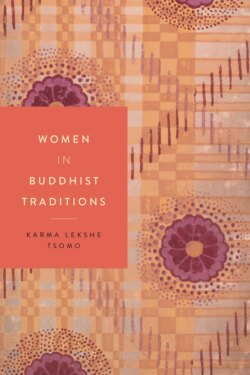Читать книгу Women in Buddhist Traditions - Karma Lekshe Tsomo - Страница 10
На сайте Литреса книга снята с продажи.
Revolutionizing the Future
ОглавлениеIn a global community that is strongly influenced by democratic ideals of justice and equality, gender discrimination is generally no longer seen as justifiable and is associated with many social problems, including domestic violence, sex trafficking, and the neglect of girls’ health and education. In the eyes of much of the world, archaic religious structures that put women at a disadvantage—materially, psychology, socially, and spiritually—run counter to a new global ethic of gender equity and seem sadly out of step with the times. Assumptions about women’s supposed karmic inferiority and the reality of their often invisible roles in Buddhist institutions—patterns that have been taken for granted for centuries—are now coming under scrutiny both in Buddhist societies and internationally. Discriminatory attitudes and patriarchal structures not only appear contradictory to the liberating teachings of the Buddha but also may cause people to question the value of pursuing Buddhist practice in today’s world, especially beyond Asia.
A dramatic increase in interest in the topic of women in Buddhism has generated a wave of new scholarship. Some studies focus on women in specific cultures or at different stages in Buddhist historical development, while others are literary analyses of the conflicting portrayals of women, as a category, that are found in Buddhist texts. As yet, however, there has been no updated introduction to women in Buddhism that offers an adequate treatment of the topic overall.
Tracing the path of Buddhism’s historical and cultural development, this book begins with a discussion of Buddhist women in the early Indian context—the Buddha’s mother, stepmother, wife, and earliest female disciples. It then moves to the lives, challenges, and achievements of women in other cultural contexts and periods of Buddhist history, up to the present day. In recounting the struggles and attainments of a range of realized and ordinary women, we will explore several salient themes, including the ways in which Buddhist teachings have been spiritually liberating for women, and also the ways in which certain teachings have been used to reinforce women’s subordination within patriarchal social structures and Buddhist institutions. Using selected examples from a variety of Buddhist cultures, we will investigate women’s unique roles within specific Buddhist societies and trace common threads among them. A transformation of Buddhist attitudes is currently taking place to envisage what social, religious, psychological, and ideological changes are needed to revolutionize Buddhist societies and institutions, and create a truly egalitarian society.
Buddhist teachings and traditions are increasingly transnational, and many antiquated attitudes are up for review. One major issue is the seeming contradiction between the internally egalitarian organizational structures modeled by the early bhikkhu and bhikkhunī saṅghas and the hierarchical structures of many Buddhist institutions today. Buddhist texts and teachings provide solutions to many forms of suffering, but they do not explicitly address the structural inequalities that underlie many forms of suffering and injustice. The ultimate goal of Buddhist practice—the achievement of liberation—is said to be beyond gender, but on a practical level gender matters very much. Without conducive circumstances for Buddhist learning and practice, the goal of liberation is merely a dream for many women. Liberation as a theoretical ideal needs to be aligned with conditions on the ground. In reality, women disproportionately experience the misfortunes of everyday life. Poor, illiterate, uneducated, and overworked, millions of women find little leisure time for Buddhist practice.
It is heartening that a revolutionary new vision of Buddhism includes a sincere concern for women and the benefits that awakened women can offer society. This new vision has spurred a vibrant transnational movement to work for Buddhist women, to allow access to all kinds of education and all levels of monastic ordination. Buddhist scholars, practitioners, and scholar/practitioners are engaged in efforts to understand the roots of gender inequities and to analyze critically the texts and unexamined assumptions that have perpetuated myths of women’s inferiority. With new research methodologies and a broader knowledge base, scholars aspire to apply these tools to a thorough reinterpretation of texts and traditions, and to uncover more information about the contributions that women have made to Buddhist thought and practice. Transcending cultural differences, new modes of communication facilitate creative and mutually beneficial international exchanges. A Buddhist feminist movement that began in the 1980s stretches across cultural boundaries to investigate the gender-specific presuppositions and limitations that not only persist in Buddhist cultures but also confine many human minds. The Buddhist feminist imagination is both a natural historical development, spurred by the global women’s movement, and an intensely personal journey for many Buddhist women, nurturing self-awareness and establishing solidarity with other women and male allies. Awakening, both as an attainment beyond gender, available to all, and as an awareness born of women’s experience, holds the promise of liberating and revolutionizing humanity.
